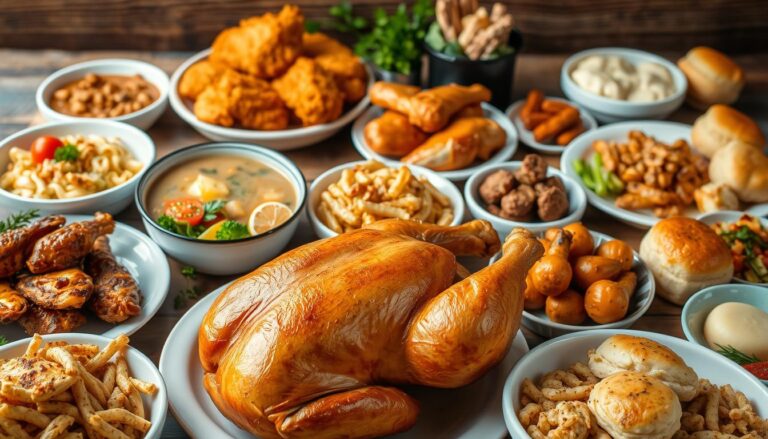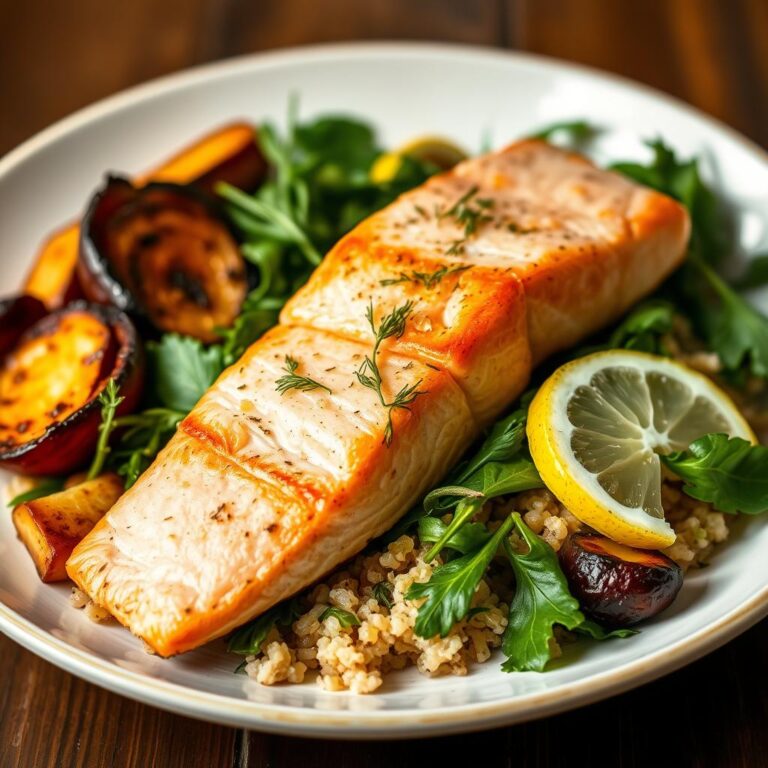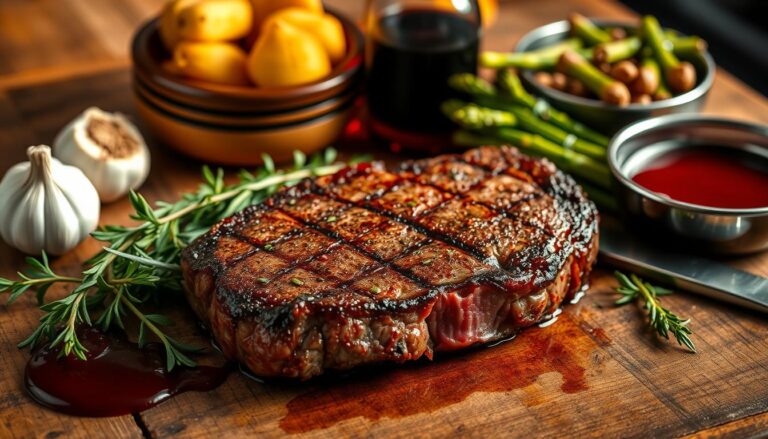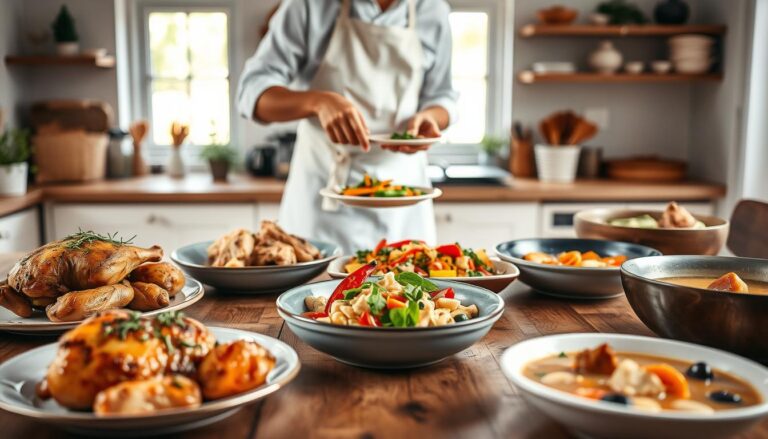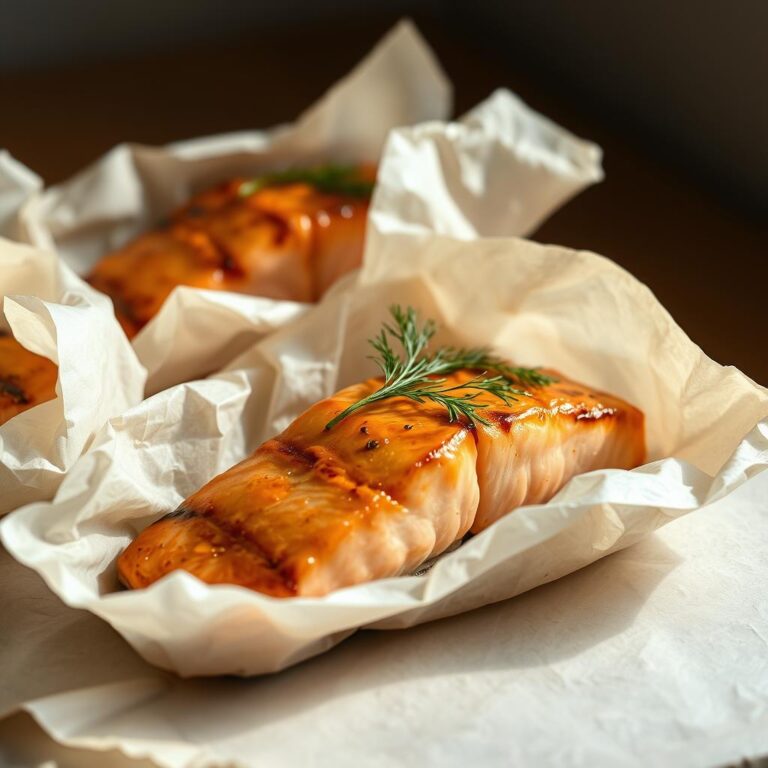Pan-Seared Salmon Recipe: The Ultimate Quick and Easy Pan-Seared Salmon
The sizzle of a perfectly cooked pan-seared salmon can turn an ordinary dinner into a special meal. As a home cook, I’ve found that making this quick salmon recipe is simpler than you think. It’s all about getting that restaurant-quality taste in just 15 minutes.
Imagine making a dish with a golden, crispy outside and a soft, flaky inside. This easy salmon recipe is not just about taste. It’s about making cooking easier while impressing everyone with a top-notch meal.
Key Takeaways
- Pan-seared salmon can be prepared in under 15 minutes
- Achieve a crispy exterior with a moist, tender interior
- Minimal ingredients required for maximum flavor
- Suitable for both novice and experienced home cooks
- Versatile recipe that can be adapted to various flavor profiles
Benefits of Pan-Seared Salmon Recipe
Exploring the health perks of salmon can change how you view food. Pan-seared salmon is more than tasty—it’s packed with nutrients that boost your health.
Heart-Healthy Fish Advantages
Salmon is a top choice for heart health. It’s full of nutrients that help your heart work better. Here are some key benefits:
- Reduces inflammation in blood vessels
- Helps lower blood pressure
- Supports healthy cholesterol levels
Omega-3 Fatty Acids Powerhouse
Salmon’s omega-3 fatty acids are a big deal for your health. These fats are vital for your brain and can lower disease risks.
Your body can’t make omega-3s on its own. So, eating salmon is a great way to get them. A few servings a week can do a lot for your health.
Premium Protein Source
Salmon is also a top protein source. It helps keep your muscles strong and aids in recovery. A serving has about 22-25 grams of protein.
Adding pan-seared salmon to your meals is a smart health move. It’s not just tasty—it’s a long-term health investment.
Essential Ingredients and Equipment Selection
Choosing the right ingredients and equipment is key to a great pan-seared salmon dish. Success in cooking depends on using top-notch items that bring out the salmon’s best flavors.
Here are the main ingredients you’ll need:
- Fresh salmon fillets (wild-caught is best)
- Extra virgin olive oil
- Kosher salt
- Freshly ground black pepper
- Optional herbs like dill or parsley
For cooking, you’ll need these tools:
- Heavy-bottomed cast iron skillet
- Non-stick pan with a thick base
- Sharp chef’s knife
- Reliable kitchen tongs
- Instant-read meat thermometer
The right equipment makes a big difference in how your salmon turns out. A cast iron skillet is great for even heat and a crispy crust. Non-stick pans are better for easy cleanup.
Quality ingredients and the right cooking tools can turn a simple salmon dish into a gourmet meal. Choose fresh, sustainable salmon and use reliable kitchen tools to improve your cooking.
Choosing the Perfect Salmon Cut
Choosing the right salmon fillet is key to a tasty pan-seared dish. The type of salmon you pick can greatly affect the taste, texture, and quality of your meal.
Knowing about different salmon types is important. Each type of salmon adds its own special qualities to your dish.
Wild Salmon vs. Farm-Raised Salmon
You’ll find two main types of salmon: wild and farm-raised. Each has its own taste and cooking benefits.
- Wild salmon has a stronger flavor
- Farm-raised salmon tastes milder
- Wild salmon is often cleaner
- Farm-raised salmon is cheaper
Optimal Thickness and Size
The thickness of your salmon fillet is very important. A 1-inch thick fillet cooks best and stays moist.
| Fillet Thickness | Cooking Recommendation |
|---|---|
| Less than 3/4 inch | Risk of overcooking, dry texture |
| 1 inch | Perfect for pan-searing |
| Over 1.5 inches | Requires longer cooking, possible uneven doneness |
Skin-On vs. Skinless Options
Think about whether you want skin-on or skinless salmon. Skin-on fillets get crispy and keep moisture in.
- Skin-on fillets get crispy
- Skinless fillets are easier to season and present
- Skin adds healthy omega-3s
Pro tip: Choose fresh, vibrant salmon with a clean smell. The right salmon fillet can make your pan-seared salmon amazing.
Preparation Techniques for Perfect Results
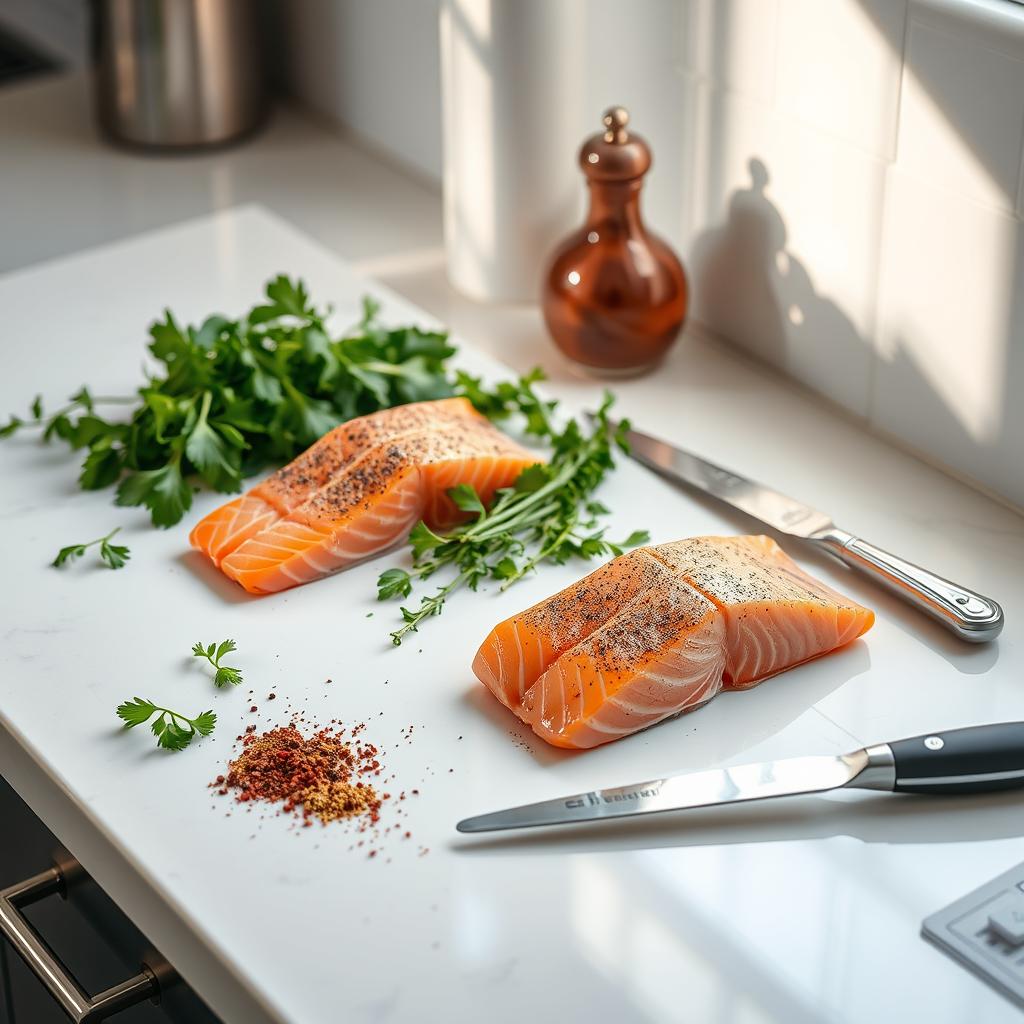
Learning how to prepare salmon is key to making a dish that rivals a restaurant’s. The first step to cooking salmon perfectly is to prepare it well. This boosts your cooking abilities.
Before you start cooking, give your salmon some prep time. Take it out of the fridge 15-20 minutes before cooking. This lets it warm up to room temperature. This ensures it cooks evenly and avoids dry edges.
- Pat the salmon dry with paper towels to remove excess moisture
- Use clean paper towels to absorb surface water completely
- Create a dry surface for optimal seasoning salmon
Seasoning salmon needs a gentle hand. Use kosher salt and black pepper lightly. Sprinkle them just before cooking to keep moisture in. For more flavor, try these:
- Gentle herb rub with dill or parsley
- Light dusting of smoked paprika
- Subtle garlic powder
Pro tip: Score the skin lightly with a sharp knife to help prevent curling and ensure even cooking. This method ensures the salmon cooks evenly. It also makes the skin crispy, taking your dish to the next level.
Pan-Seared Salmon Recipe
Learning to cook salmon is all about precision and mastering key techniques. Pan-searing salmon turns a simple fish into a gourmet dish with little effort.
Basic Seasoning Steps
Start by seasoning your salmon right. Dry the fillet with paper towels for a crispy outside. Then, season it well with:
- Kosher salt
- Freshly ground black pepper
- Optional herbs like dill or thyme
Cooking Temperature Guidelines
Getting the right temperature is key for perfect salmon. Heat a cast-iron skillet or heavy pan to medium-high. This ensures the salmon cooks evenly.
Timing and Doneness Indicators
Here are the expert tips for cooking salmon just right:
- Cook skin-side down for 4 minutes
- Flip and cook for an additional 3-4 minutes
- Check internal temperature reaches 130°F (54°C) for medium
Pro tip: Look for opaque flesh and easy flaking as visual cues for proper salmon doneness.
Creating the Perfect Crispy Skin
Making crispy salmon skin is an art that turns a simple fish dish into a masterpiece. It’s all about finding the right mix of moisture, heat, and technique.
To get crispy salmon skin, start by drying your salmon fillet with paper towels. Getting rid of extra moisture is key. Then, season the skin side with salt to help dry it out and brown evenly.
- Use a heavy-bottomed skillet for maximum heat retention
- Ensure the pan is very hot before adding salmon
- Use a minimal amount of high smoke-point oil
Experts say to put the salmon skin-side down in a hot pan. Press gently with a spatula to make sure the skin touches the pan. This helps it crisp up evenly and prevents it from curling.
Don’t move the salmon while it’s cooking. Let it cook for 3-4 minutes until it’s golden brown. Then, flip it gently. You’ll get a crispy skin that crackles with every bite, making your meal feel like it’s from a restaurant.
Herb and Butter Sauce Variations
Make your salmon sauce recipes special with herb butter. It turns a simple dish into a gourmet delight. The right sauce can make your pan-seared salmon taste amazing.
Creating the perfect herb butter for salmon is all about flavor balance. Your sauce can either make or break the meal.
Classic Lemon Butter Sauce
Lemon butter salmon sauce is a favorite among cooks. Its bright, zesty taste pairs well with rich salmon.
- Fresh lemon juice
- Unsalted butter
- Minced fresh herbs
Fresh Herb Combinations
Try these classic herb butter pairings for salmon:
| Herb | Flavor Profile | Best Paired With |
|---|---|---|
| Dill | Bright, tangy | Wild-caught salmon |
| Parsley | Fresh, clean | Grilled salmon |
| Thyme | Earthy, subtle | Baked salmon |
Garlic and Wine Options
Add white wine and garlic for a richer flavor. Use gentle heat and careful reduction to get the best taste.
- Use dry white wine for depth
- Mince fresh garlic finely
- Reduce sauce slowly to concentrate flavors
Your salmon sauce can be a game-changer. Start with these recipes and let your creativity shine!
Professional Tips for Restaurant-Quality Results

To make your salmon dish stand out, learn a few key techniques. These methods turn a simple meal into a gourmet delight. Chefs use these secrets to cook salmon that looks great and tastes amazing.
Here are some top tips from culinary experts:
- Use a fish spatula for delicate handling and precise flipping
- Remove salmon from heat when it’s slightly undercooked to prevent overcooking
- Let the fish rest for 2-3 minutes before serving to retain moisture
- Finish with high-quality extra virgin olive oil or flaky sea salt
Temperature control is key. Cook at medium-high heat for a crispy outside and a tender inside. A cast-iron skillet is best for even heat and a perfect sear.
How you present your dish is just as important as how it tastes. Serve your salmon at an angle, add fresh herbs, and drizzle a bit of sauce. These techniques will make your salmon look and taste like it’s from a fancy restaurant.
Storage and Reheating Guidelines
Storing cooked salmon right is key to keeping its taste and avoiding food poisoning. After you cook your pan-seared salmon, make sure it stays safe and delicious for later.
Here are the main steps for storing cooked salmon:
- Cool the salmon completely before refrigerating
- Use an airtight container to prevent moisture loss
- Refrigerate within two hours of cooking
- Store for a maximum of 3 days in the refrigerator
Reheating salmon needs a gentle touch to keep its soft texture. Here are some good ways to reheat salmon:
- Oven method: Preheat to 275°F and warm for 10-15 minutes
- Stovetop technique: Use low heat with a small amount of oil or butter
- Avoid microwave reheating, which can dry out the fish
To avoid dryness, add a bit of water or broth when reheating. This keeps the fish moist and tender. You can also turn leftover salmon into tasty salads, pasta dishes, or quick lunches.
Food safety is always first. If salmon has been stored for more than three days or looks spoiled, throw it away. Always listen to your gut and if unsure, it’s better to be safe than sorry.
Conclusion
Learning how to pan-sear salmon opens up a world of tasty and healthy meals. This simple recipe turns a basic ingredient into a dish that wows everyone. You’ll get a crispy outside and a soft, flaky inside every time.
This recipe is super versatile, so you’ll never run out of ideas. Try different sauces like lemon butter or unique herb mixes. You’ll boost your cooking skills and enjoy a meal full of omega-3s and protein.
Don’t hesitate to try new things and make the recipe your own. Start with the basics, then add your favorite flavors and spices. Each time, you’ll get better and find your own cooking style. Remember, the joy of cooking comes from the passion, practice, and fun of making something delicious.
Your salmon-cooking adventure begins today. Enjoy the simplicity, the flavors, and the fun of cooking. Whether it’s a quick dinner or a big event, your pan-seared salmon will be a favorite dish.


